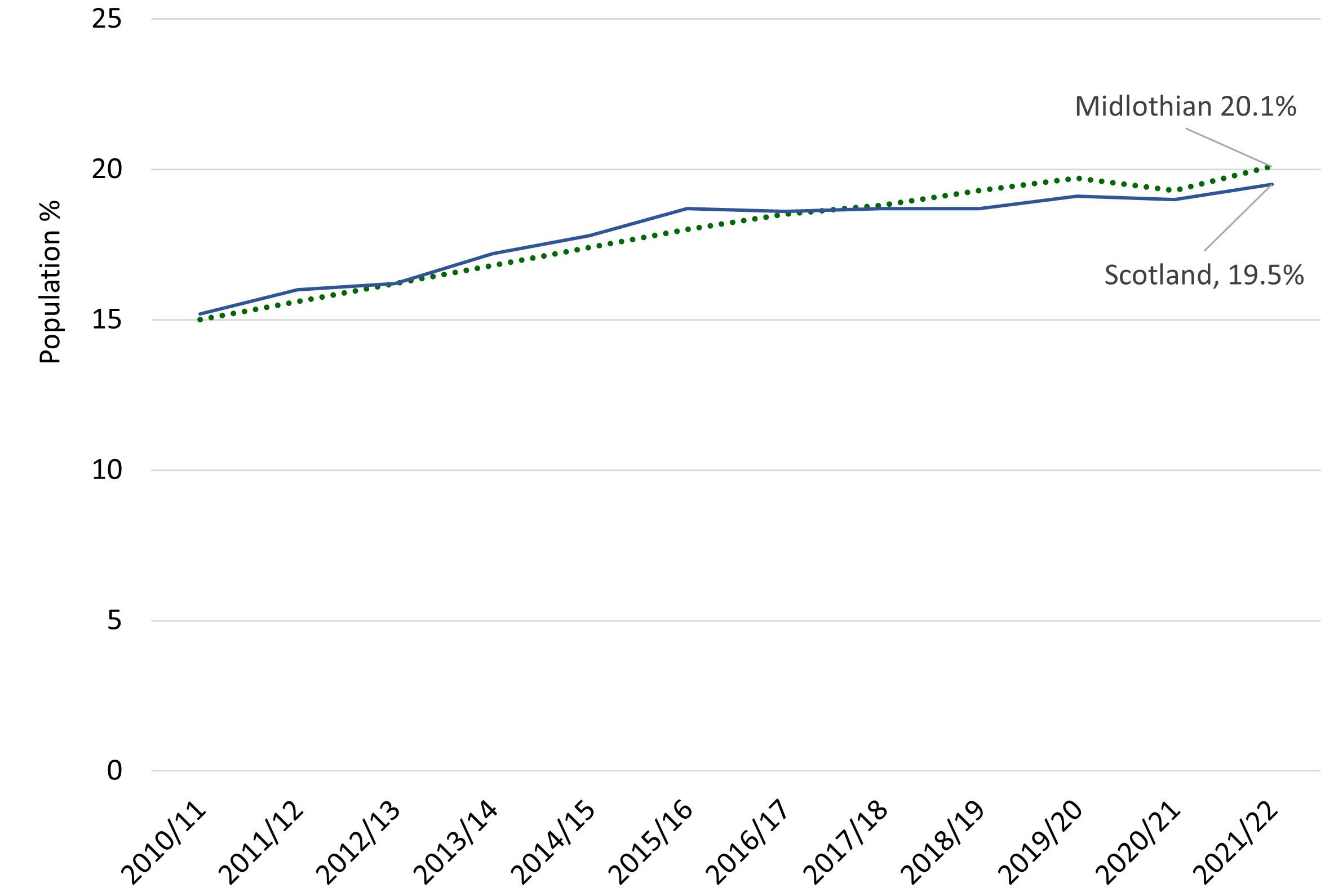Mental Health, Social Isolation & Loneliness - Data
Consultations
Impact Assessments
Data
Mental health is described by WHO as ‘a state of well-being in which the individual realizes his or her own abilities, can cope with the normal stresses of life, can work productively and fruitfully, and is able to make a contribution to his or her community.’
Percentage of the population prescribed drugs for depression, anxiety and/ or psychosis, Midlothian and Scotland, 2012/13 - 2021/22
Data source: Scottish Public Health Observatory

In Midlothian 4.2% of people identified themselves as living with a mental health condition that had lasted or was expected to last 12 months (National Records of Scotland, 2021). In the 2018 Health and Social Care Survey 23% of all respondents answered ‘no’ to the question ‘Do you have good mental wellbeing’ and 62% of staff responded that they did not feel Services make it easy for people to sustain good mental health (Midlothian Health and Social Care Partnership, 2019).
In 2021/2 19.5% of the Midlothian population were prescribed drugs for depression, anxiety and/ or psychosis. This has increased from 16.2% in 2012/13. The proportion of the Scottish population prescribed has also increased since 2012/13. For the most deprived SIMD in Midlothian this rises to 23% (National Records of Scotland, 2021)
Loneliness & Social Isolation
Though often considered together, it is important to draw a distinction between social isolation and loneliness:
- Social Isolation is an objective status and can be defined by the quantity of social relationships and contacts.
- Loneliness is a subjective experience (a negative emotion) associated with a perceived gap in the quality and quantity of relationships that we have and of those we want.
There is no ‘typical profile’ of someone at risk of social isolation or loneliness and patterns are not equally distributed across the population. However, we know that social isolation and loneliness can contribute to poor health and wellbeing. Both social isolation and loneliness were significantly associated with an increased risk of all-cause mortality and cancer mortality (Wang et al. 2023) The effect of loneliness and isolation on mortality is comparable to the impact of well-known risk factors such as obesity and has a similar influence as cigarette smoking (Holt-Lunstad et al. 2010)
Scottish Government has identified loneliness and isolation as a major health threat to Scotland’s population. Previously initiatives have focussed on the needs of the elderly and their informal carers. It is now recognised through the growing body of evidence that these issues affect and are impinging at all life stages.
91% of people feel connected to friends and family (Midlothian Council, 2020) Carers UK suggests that eight out of 10 carers feel lonely or isolated.
Academic research is clear that preventing and alleviating loneliness is vital to enabling older people to remain as independent as possible. Lonely individuals are more likely to:
- Visit their GP, have higher use of medication, higher incidence of falls and increased risk factors for long term care
- Undergo early entry into residential or nursing care
- Use accident and emergency services independent of chronic illness
Suicide
Suicide may be defined as intentionally killing oneself. The figures in Scotland are a combination of two groups of causes of death: intentional self-harm and events of undetermined intent. For some deaths it is straightforward to determine the intention of the deceased. For other types of death, it is not. The convention in Scotland has been to include both types so that all suicides are captured. At a Midlothian level the number of events is quite small and therefore subject to quite wide fluctuation year to year, so it is often better to combine years into 5-year blocks.
The average number of suicides per year based on the 5 year average in Midlothian between 2011-15 and 2017-21 ranges between 12 to 13.6 per year.
The Scottish EASR five-year rate per 100,000 for 2017-2021 of 14.1 is an increase on the previous 5-year rate (13.4). However, for the same time periods the latest rates for Lothian (11.8) and Midlothian (12.9) are a decrease from 2012-2016 (ScotPHO 2022).
Due to smaller numbers of suicides in Midlothian and duty to protecting individual identity, it is not possible to provide Midlothian age rates (ScotPHO, 2022). Across Scotland over the previous 10-year period from 2012-2021 there is a general consistency in trend with most suicides being amongst younger to middle-aged men from the most deprived areas (ScotPHO, 2022).
Page updated: June 2024
